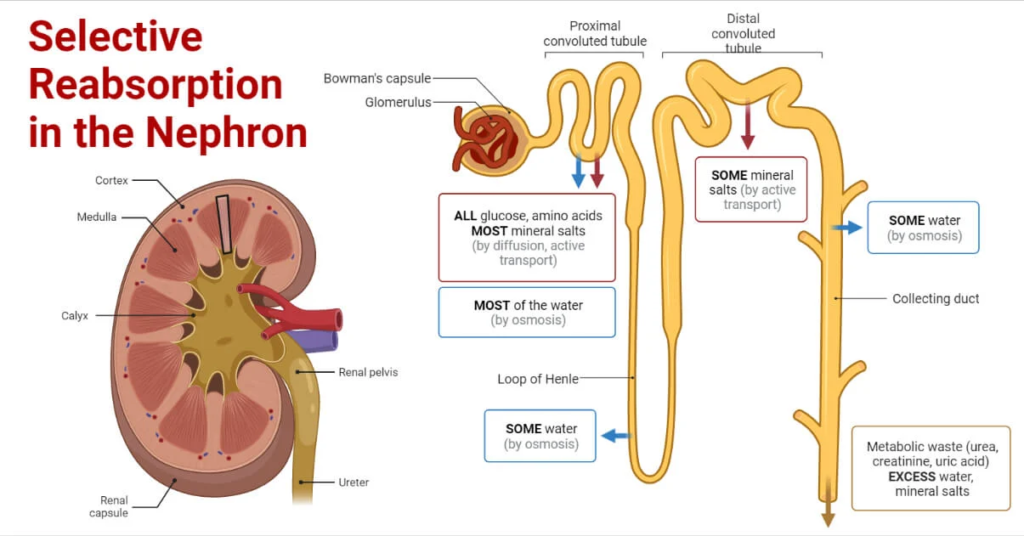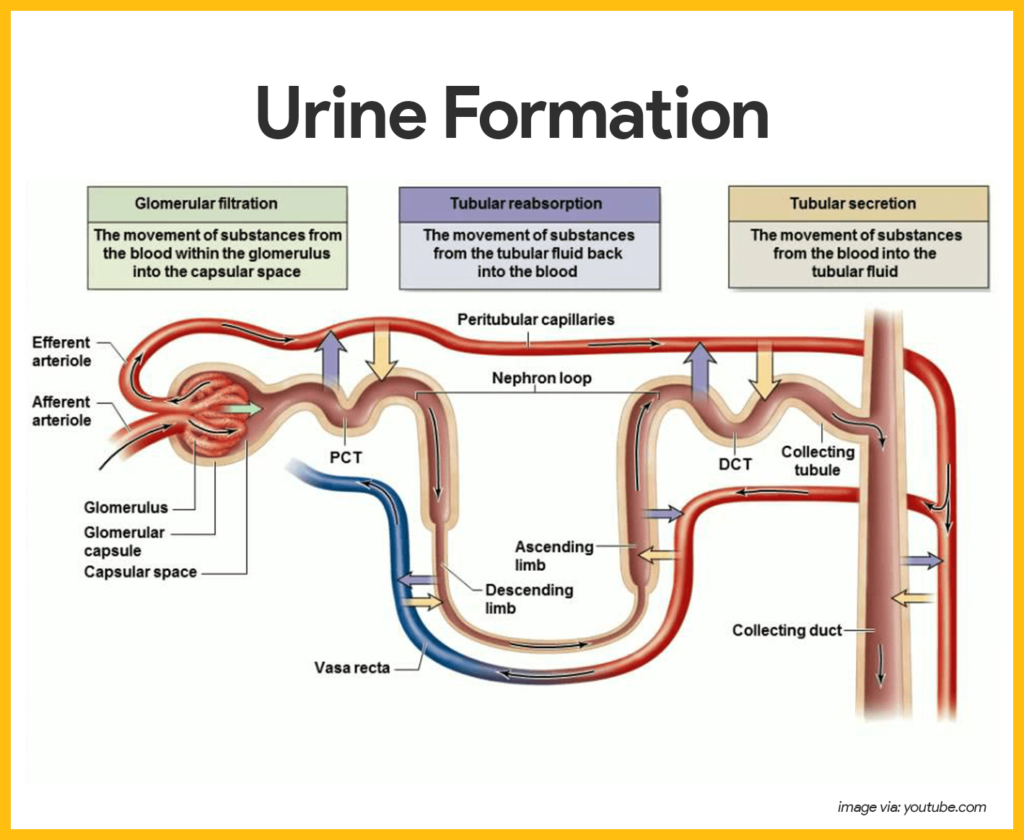Interesting Notes of 10th class Biology with Syeda Naqvi
Chapter 11: Homeostasis

Understand The Concept
Question 1: Describe the process of selective re-absorption in the kidneys.

Answer:
Selective reabsorption is a crucial process in the kidneys that helps maintain the body’s balance of water, salts, and other substances. After blood is filtered in the kidneys, the resulting fluid (called filtrate) contains many useful substances that the body needs, such as glucose, amino acids, and certain ions. These substances are reabsorbed back into the bloodstream from the filtrate. Here’s how it happens:
- Proximal Convoluted Tubule (PCT): Most reabsorption occurs here. Useful substances like glucose, amino acids, and a significant amount of water and sodium ions are reabsorbed into the blood.
- Loop of Henle: This part concentrates the urine. In the descending limb, water is reabsorbed, making the filtrate more concentrated. In the ascending limb, sodium and chloride ions are reabsorbed without water, diluting the filtrate.
- Distal Convoluted Tubule (DCT) and Collecting Duct: Further reabsorption of water and ions occurs here, regulated by hormones like aldosterone and antidiuretic hormone (ADH).
Question 2: How do the plants excrete extra water and salts from their bodies?

Answer:
Plants have different methods to excrete extra water and salts:
- Transpiration: This is the process where water evaporates from the surface of leaves, mainly through small openings called stomata. This helps in getting rid of excess water.
- Guttation: Sometimes, water is exuded from the tips or edges of leaves in liquid form, especially at night. This occurs through special structures called hydathodes.
- Salt Glands: Some plants, especially those in saline environments, have specialized glands to excrete excess salts.
Question 3: What is the functional unit of the kidney? Describe its structure.

Answer:
The functional unit of the kidney is the nephron. Each kidney contains about a million nephrons, and they are responsible for filtering blood and forming urine.
Structure of a Nephron:
- Bowman’s Capsule: A cup-shaped structure that encases the glomerulus (a network of capillaries). Blood filtration starts here.
- Proximal Convoluted Tubule (PCT): The twisted tube where most reabsorption of nutrients, water, and ions occurs.
- Loop of Henle: A U-shaped tube that further concentrates the filtrate by reabsorbing water and salts.
- Distal Convoluted Tubule (DCT): Another twisted section where additional reabsorption and secretion take place.
- Collecting Duct: The final part where urine is collected and transported to the renal pelvis.
Question 4: What steps are involved in the formation of urine in the kidneys?

Answer:
The process of urine formation involves three main steps:
- Filtration: Blood enters the glomerulus, and water and small molecules are filtered into Bowman’s capsule, forming filtrate.
- Reabsorption: Useful substances like glucose, amino acids, and ions are reabsorbed from the filtrate back into the blood, mostly in the PCT.
- Secretion: Additional waste products and excess ions are secreted from the blood into the filtrate in the DCT and collecting duct.
Finally, the resulting fluid, now called urine, is collected in the renal pelvis, travels down the ureters to the bladder, and is eventually excreted.
Question 5: “Along with excretion, kidneys also play a role in Osmoregulation.” Comment on this statement.

Answer:
Osmoregulation is the process of maintaining the balance of water and solutes (like salts) in the body. The kidneys play a crucial role in this by:
- Adjusting Water Reabsorption: The kidneys can reabsorb more or less water depending on the body’s hydration levels. For example, when dehydrated, the hormone ADH increases water reabsorption in the kidneys, producing concentrated urine.
- Regulating Salt Balance: The kidneys can excrete excess salts and retain needed ions to maintain proper electrolyte levels in the blood.
- Maintaining Blood Pressure: By controlling blood volume (through water reabsorption) and secreting the enzyme renin, regulates blood pressure.
In summary, the kidneys not only remove waste products but also ensure that the body’s internal environment remains stable and balanced, which is vital for overall health.
SHORT QUESTIONS
Question 1: What are the major organs involved in homeostasis in the human body? State the roles of each of these organs.
Answer:
Homeostasis is the process by which the human body maintains a stable internal environment despite changes in external conditions. Several major organs play key roles in this process:
- Brain (Hypothalamus): Acts as the control center for many homeostatic processes, regulating body temperature, hunger, thirst, and circadian rhythms. It also controls the release of hormones from the pituitary gland.
- Liver: Detoxifies chemicals, metabolizes drugs, and processes nutrients absorbed from the digestive tract. It also regulates blood glucose levels by storing and releasing glucose as needed.
- Kidneys: Filter blood to remove waste products and excess substances, regulate water balance and electrolytes, and maintain acid-base balance.
- Lungs: Facilitate gas exchange, supplying oxygen to the blood and removing carbon dioxide. They also help maintain acid-base balance by regulating the levels of carbon dioxide in the blood.
- Pancreas: Regulates blood sugar levels by producing insulin and glucagon.
- Skin: Regulates body temperature through sweating and vasodilation or vasoconstriction of blood vessels.
SCIENCE, TECHNOLOGY AND SOCIETY
Question 1: Realize the importance of drinking plentiful water daily.
Answer:
Drinking plenty of water daily is crucial for maintaining good health for several reasons:
- Hydration: Water is essential for maintaining the balance of bodily fluids, which are involved in digestion, absorption, circulation, and temperature regulation.
- Kidney Function: Adequate water intake helps the kidneys filter waste from the blood and excrete it as urine, preventing kidney stones and urinary tract infections.
- Cellular Function: Every cell in the body needs water to function properly, as it is involved in biochemical reactions, nutrient transport, and waste removal.
- Physical Performance: Staying hydrated improves physical performance by maintaining energy levels, reducing fatigue, and preventing heat stress.
- Skin Health: Drinking enough water helps keep the skin hydrated, improving its elasticity and appearance.
Question 2: Predict how the kidney helps to overcome the problem of dehydration.
Answer:
When the body is dehydrated, the kidneys help to conserve water and overcome dehydration through the following mechanisms:
- Concentrating Urine: The kidneys reduce urine output by reabsorbing more water back into the bloodstream, making the urine more concentrated.
- Release of Antidiuretic Hormone (ADH): In response to dehydration, the pituitary gland releases ADH, which signals the kidneys to reabsorb more water from the filtrate.
- Renin-Angiotensin-Aldosterone System (RAAS): Dehydration triggers the release of renin from the kidneys, leading to the production of angiotensin II, which stimulates the release of aldosterone. Aldosterone increases sodium reabsorption, which in turn increases water reabsorption.
Question 3: Recognize the right treatments for kidney problems.
Answer:
Treatments for kidney problems vary depending on the specific condition but generally include:
- Medications: To control symptoms and slow the progression of kidney disease, such as antihypertensives to manage high blood pressure, and medications to control blood glucose levels in diabetic patients.
- Dietary Changes: A kidney-friendly diet can help reduce the workload on the kidneys. This often includes reducing salt, protein, and phosphorus intake, and maintaining proper hydration.
- Dialysis: For patients with advanced kidney disease or kidney failure, dialysis can remove waste products and excess fluids from the blood when the kidneys are no longer able to perform these functions.
- Kidney Transplant: In cases of end-stage renal disease, a kidney transplant may be necessary. This involves replacing the damaged kidney with a healthy one from a donor.
- Regular Monitoring: Routine check-ups and tests to monitor kidney function and detect any changes early, allowing for timely intervention.
Understanding these aspects of kidney health and homeostasis emphasizes the importance of maintaining a healthy lifestyle and seeking appropriate medical care when needed.

References
- Gordon., Betts, J. Anatomy and physiology. DeSaix, Peter., Johnson, Eddie., Johnson, Jody E., Korol, Oksana., Kruse, Dean H., Poe, Brandon. Houston, Texas. p. 9. ISBN 978-1-947172-04-3. OCLC 1001472383.
- Martin, Elizabeth (2008). A dictionary of biology (6th ed.). Oxford: Oxford University Press. pp. 315–316. ISBN 978-0-19-920462-5.
- Biology Online (27 October 2019). “Homeostasis”. Biology Online. Archived from the original on 12 August 2020. Retrieved 27 October 2019.
- Jump up to:a b Kalaany, NY; Mangelsdorf, DJ (2006). “LXRS and FXR: the yin and yang of cholesterol and fat metabolism”. Annual Review of Physiology. 68: 159–91. doi:10.1146/annurev.physiol.68.033104.152158. PMID 16460270.
- Jump up to:a b c Marieb EN, Hoehn KN (2009). Essentials of Human Anatomy & Physiology (9th ed.). San Francisco: Pearson/Benjamin Cummings. ISBN 978-0-321-51342-7.
- Lovinger, David M. (2008), “Presynaptic Modulation by Endocannabinoids”, in Südhof, Thomas C.; Starke, Klaus (eds.), Pharmacology of Neurotransmitter Release, Handbook of Experimental Pharmacology, vol. 184, Springer Berlin Heidelberg, pp. 435–477, doi:10.1007/978-3-540-74805-2_14, ISBN 978-3-540-74805-2, PMID 18064422
- Freitas, Hércules Rezende; Isaac, Alinny Rosendo; Malcher-Lopes, Renato; Diaz, Bruno Lourenço; Trevenzoli, Isis Hara; Reis, Ricardo Augusto De Melo (26 November 2018). “Polyunsaturated fatty acids and endocannabinoids in health and disease”. Nutritional Neuroscience. 21 (10): 695–714. doi:10.1080/1028415X.2017.1347373. ISSN 1028-415X. PMID 28686542. S2CID 40659630.
- “Homeostasis”. Merriam-Webster.com Dictionary.
- “Homeostasis”. Dictionary.com Unabridged (Online). n.d.
- Jump up to:a b Cannon, W.B. (1932). The Wisdom of the Body. New York: W. W. Norton. pp. 177–201.
- Jump up to:a b Cannon, W. B. (1926). “Physiological regulation of normal states: some tentative postulates concerning biological homeostatic”. In A. Pettit (ed.). A Charles Riches amis, ses collègues, ses élèves (in French). Paris: Les Éditions Médicales. p. 91.
External links
- Homeostasis Archived 15 August 2017 at the Wayback Machine
- Walter Bradford Cannon, Homeostasis (1932)
Post Comment